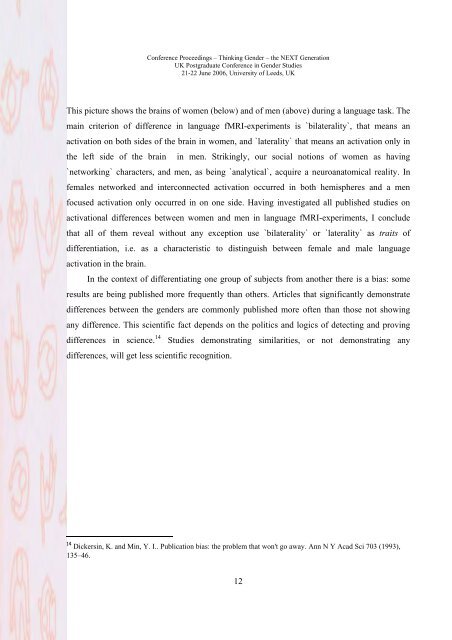On Geschlecht in Brain Science Experiments Anelis Kaiser LSE ...
On Geschlecht in Brain Science Experiments Anelis Kaiser LSE ...
On Geschlecht in Brain Science Experiments Anelis Kaiser LSE ...
You also want an ePaper? Increase the reach of your titles
YUMPU automatically turns print PDFs into web optimized ePapers that Google loves.
Conference Proceed<strong>in</strong>gs – Th<strong>in</strong>k<strong>in</strong>g Gender – the NEXT Generation<br />
UK Postgraduate Conference <strong>in</strong> Gender Studies<br />
21-22 June 2006, University of Leeds, UK<br />
This picture shows the bra<strong>in</strong>s of women (below) and of men (above) dur<strong>in</strong>g a language task. The<br />
ma<strong>in</strong> criterion of difference <strong>in</strong> language fMRI-experiments is `bilaterality`, that means an<br />
activation on both sides of the bra<strong>in</strong> <strong>in</strong> women, and `laterality` that means an activation only <strong>in</strong><br />
the left side of the bra<strong>in</strong> <strong>in</strong> men. Strik<strong>in</strong>gly, our social notions of women as hav<strong>in</strong>g<br />
`network<strong>in</strong>g` characters, and men, as be<strong>in</strong>g `analytical`, acquire a neuroanatomical reality. In<br />
females networked and <strong>in</strong>terconnected activation occurred <strong>in</strong> both hemispheres and a men<br />
focused activation only occurred <strong>in</strong> on one side. Hav<strong>in</strong>g <strong>in</strong>vestigated all published studies on<br />
activational differences between women and men <strong>in</strong> language fMRI-experiments, I conclude<br />
that all of them reveal without any exception use `bilaterality` or `laterality` as traits of<br />
differentiation, i.e. as a characteristic to dist<strong>in</strong>guish between female and male language<br />
activation <strong>in</strong> the bra<strong>in</strong>.<br />
In the context of differentiat<strong>in</strong>g one group of subjects from another there is a bias: some<br />
results are be<strong>in</strong>g published more frequently than others. Articles that significantly demonstrate<br />
differences between the genders are commonly published more often than those not show<strong>in</strong>g<br />
any difference. This scientific fact depends on the politics and logics of detect<strong>in</strong>g and prov<strong>in</strong>g<br />
differences <strong>in</strong> science. 14 Studies demonstrat<strong>in</strong>g similarities, or not demonstrat<strong>in</strong>g any<br />
differences, will get less scientific recognition.<br />
14<br />
Dickers<strong>in</strong>, K. and M<strong>in</strong>, Y. I.. Publication bias: the problem that won't go away. Ann N Y Acad Sci 703 (1993),<br />
135–46.<br />
12


